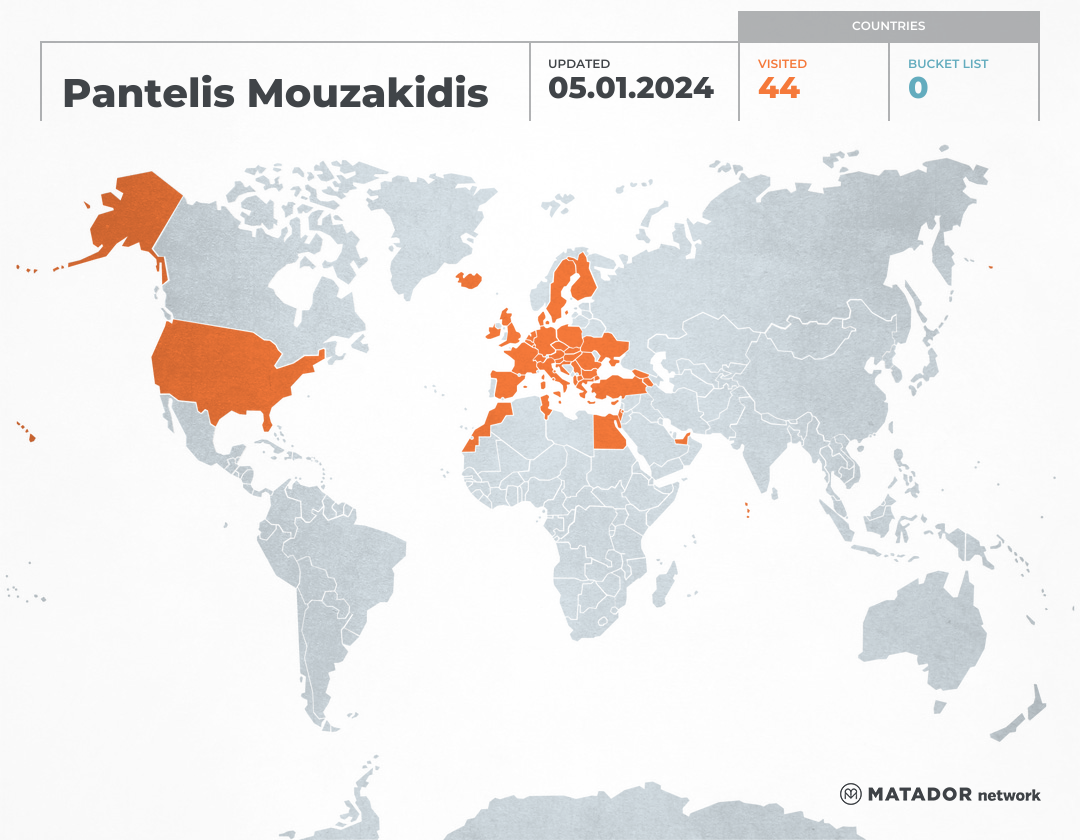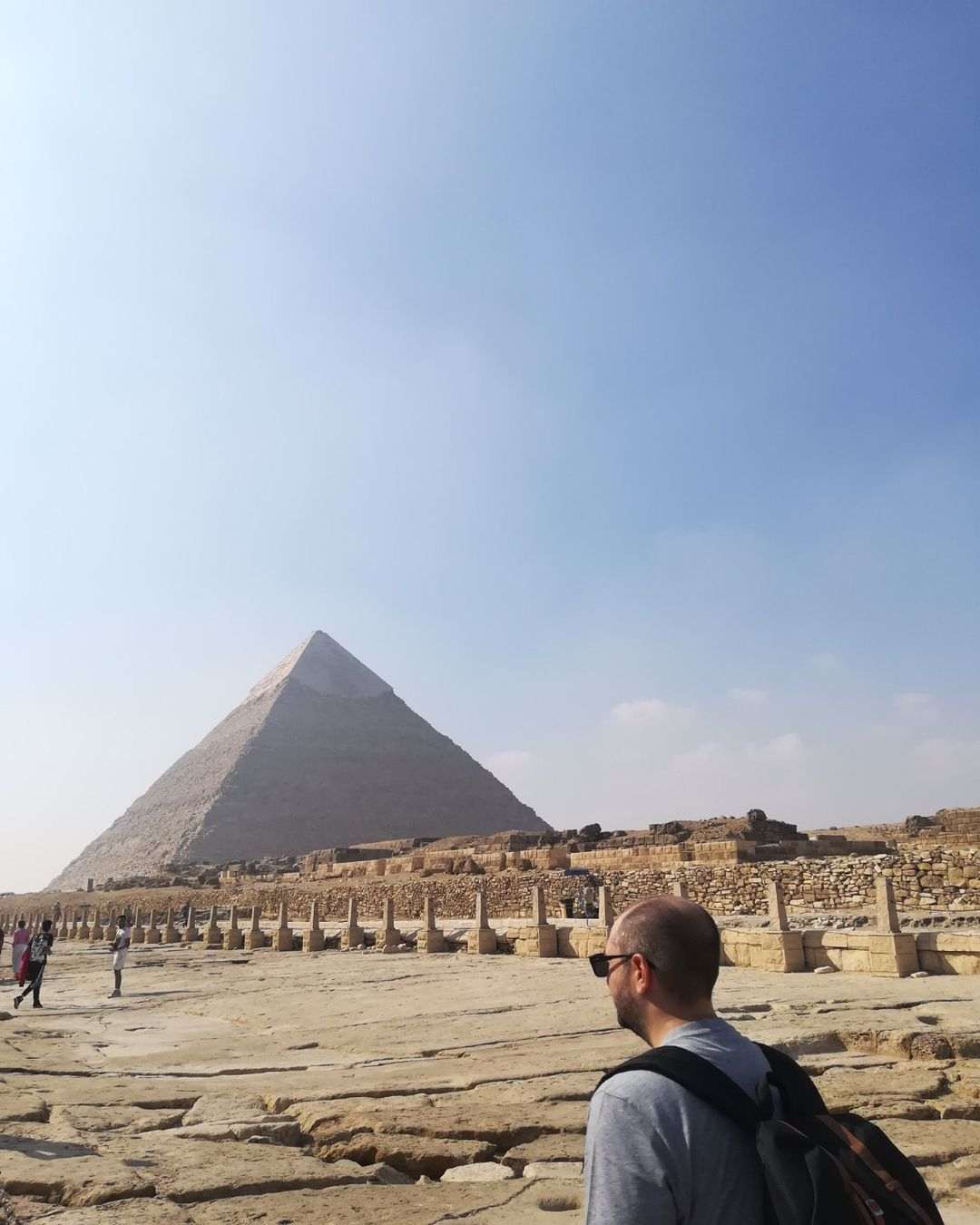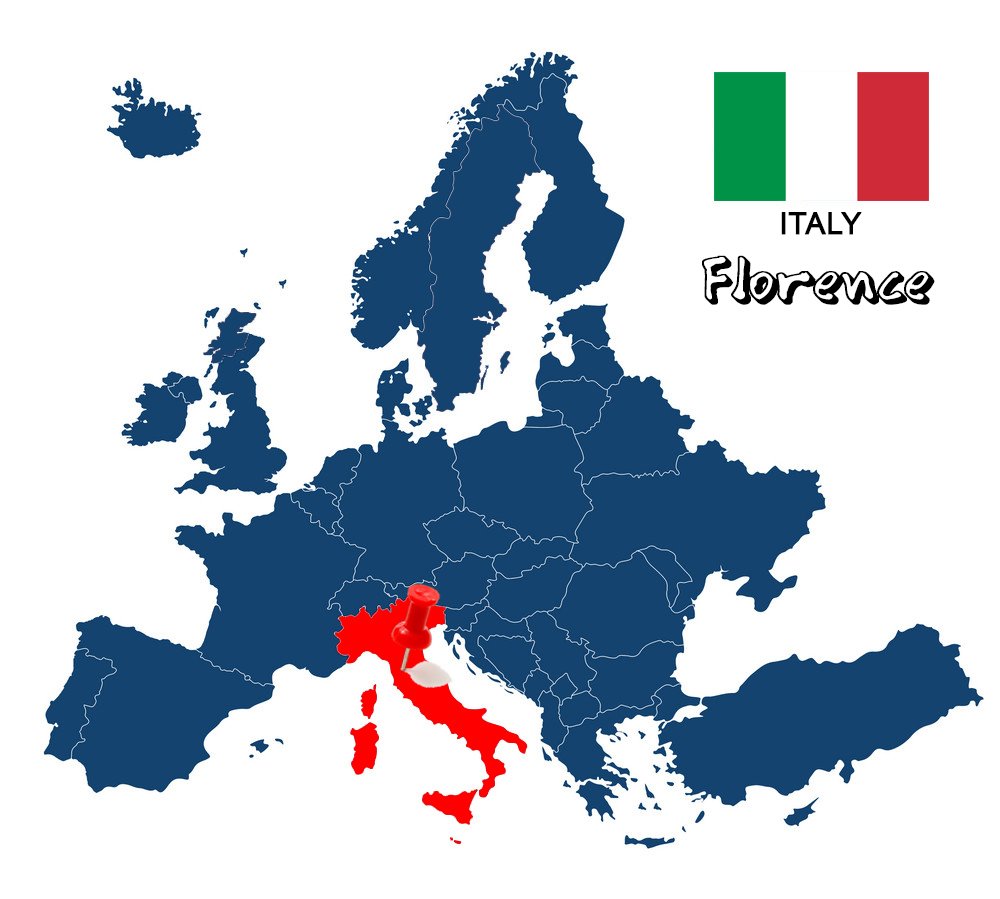
For many Florence is the most beautiful city in Italy and the truth is that they have every reason to believe it. Its magnificent landscapes, stunning works of art, architecture and incredible charm are the ingredients of an insanely enchanting, incurably romantic and absolutely unique city. I visited the city during a tour in central Italy, and to be honest, I didn't want to leave. So I said to myself that "the most beautiful things don't last long" and I promised that someday I would return to this earthly paradise, as I did.
A few words about the city
Florence is located in central Italy and is the capital of the region of Tuscany and the homonymous province, with a population of 400,000 inhabitants. It is crossed by the river Arno, which made the city a center of commerce during the Middle Ages, and from 1865 to 1870 it was the capital of the Kingdom of Italy. The legend says that the first people who visited Florence said that "this city is doomed to bloom", which is why they called it "Florentia." No one can judge them, since Florence has written history in the arts, commerce and economics, reaching the cradle of the Italian Renaissance. So I will try to present Florence through my eyes and share with you what I think someone should see, visiting for the first time.
Piazza di Duomo
The square of the Cathedral (Piazza di Duomo) is the most central and at the same time the most emblematic point of Florence. In the center of the square dominates one of the most beautiful and impressive cathedrals in the world, the church of Santa Maria del Fiore. It is a Gothic masterpiece, which was built over two centuries (1296-1436), and its dimensions are awe-inspiring, since it covers an area of 8,300 square meters! It is adorned with elaborate facades of beautiful Tuscan marble and countless colorful statues, but undoubtedly what stands out the most is Brunelleschi's massive dome, which was built without scaffolding! The interior of the temple is just as impressive as the exterior, as it is decorated with frescoes by Vasari on the theme of Judgment Day. I suggest climbing the 463 steps of the dome, which will take you up to the top, to admire the wonderful "red" view of the city.
A special part of the church is Giotto's imposing bell tower (Campanile di Giotto). It is a towering building, which is about 85 meters high, a similar height to that of the dome of Santa Maria del Fiore. It is considered one of the most beautiful in Italy, thanks to the excellent harmony of its colors and proportions. The construction of the bell tower was started in 1334 by Giotto, who unfortunately did not see his work completed. After his death, the baton was passed to Andrea Pisano, who completed the construction of the bell tower in 1359! If the view from the Duomo is magnificent, then there are no words to describe the images you will see when you climb the 414 steps of this particular bell tower.
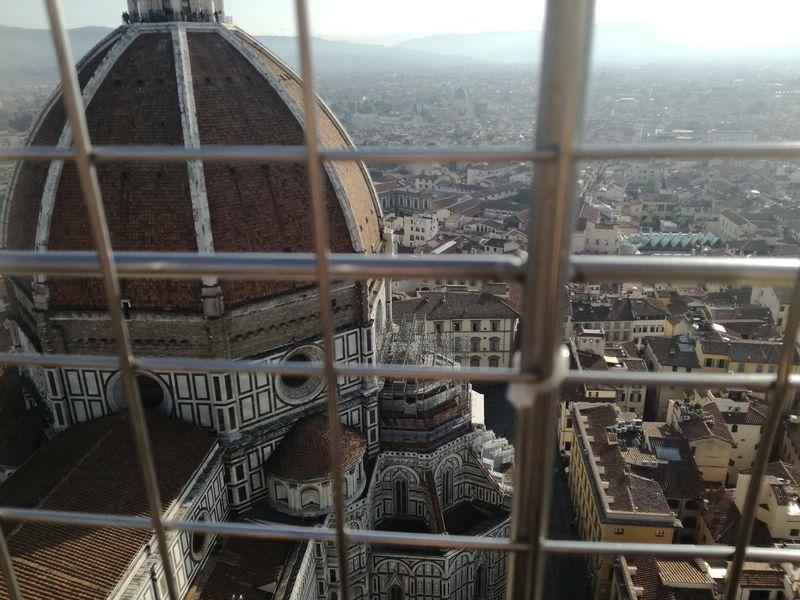
The triptych of beauty in this particular square is completed by the Baptistery of Saint John (Battistero di San Giovanni). This is another renaissance piece of art, the origin of which is unknown. It is believed to have been built on the ruins of a Roman temple dedicated to Mars, dating back to the 4th century AD. Also, the Baptistery is dedicated to the patron saint of Florence, has an octagonal plan and an octagonal domed lantern, and is famous for its Gates of Paradise, the ornate doors designed by Ghiberti and Michelangelo. Until the end of the 19th century, all Catholics in the city were baptized within its doors. Today, small children can still be baptized here on the first Sunday of the month, but as they only have room and time for four, parents have to submit their request long before.
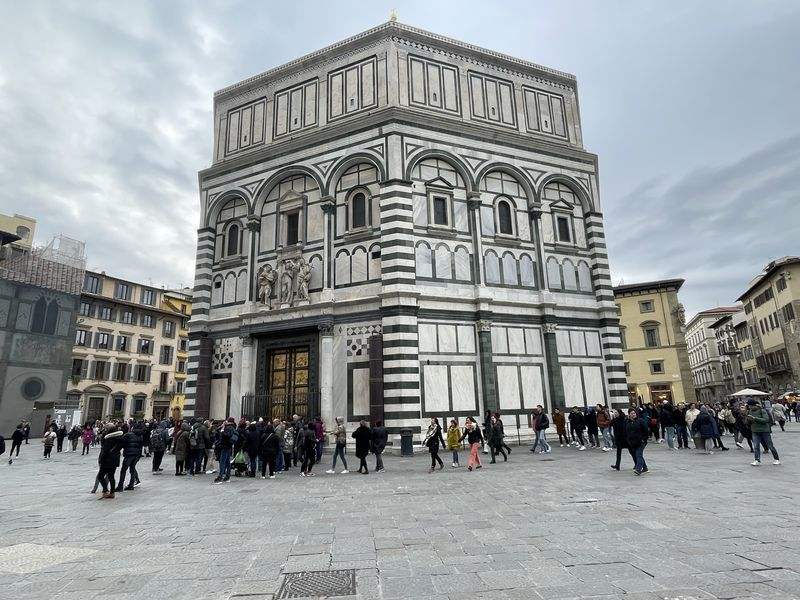
You should know that in order to enter the temple and the Baptistery, you must have booked your tickets online, as they are not sold at the ticket offices. If for any reason you are not able to make it, you can only enter the Bell tower, in which there are separate tickets, but the line is huge. Also don't make the mistake and go straight from one to the other, as the stairs are innumerable, and you don't want to stay crushed in the middle of the building.
Galleria degli Uffizi
The Uffizi Gallery (Galleria degli Uffizi) is the most important Museum in Florence, one of the most famous in Italy and probably the whole world. It was created in 1560 during the Medici period in order to accommodate their offices there (hence its name), but gradually some rooms on the third floor were granted to house the first objects of art of their collection. Over the centuries it has reached its present form, a horseshoe-shaped architectural maze, starting from the famous Piazza della Signoria Square and reaching the Arno River. The queues are endless and I would recommend booking your tickets online, which cost 12e from November to February and 25e from March to October, to save hours of standing and waiting. No matter how long you wait, Galleria degli Uffizi will thrill you. In the 45 rooms of the gallery, you will find paintings and statues by artists such as Michelangelo, Leonardo Da Vinci, Giotto, Tiziano, Caravaggio, Rembrandt and Botticelli, with the most famous being the "Venus."
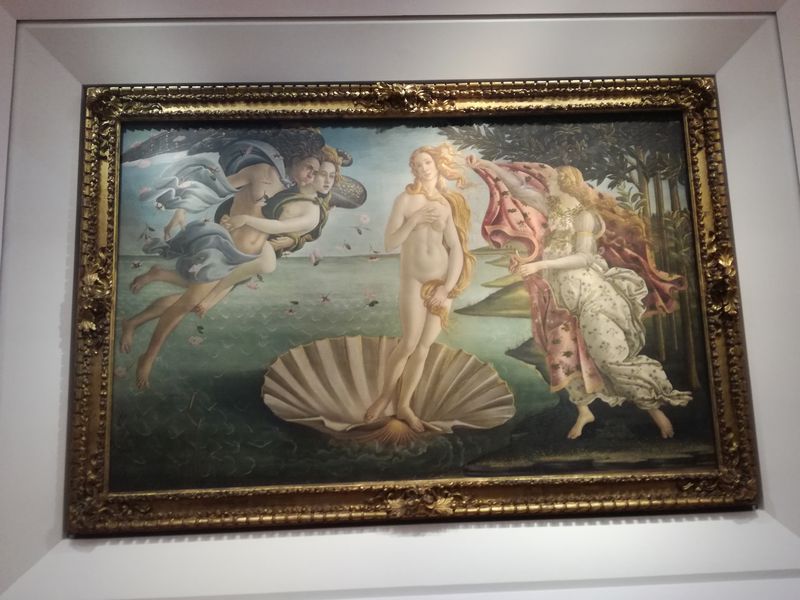
Galleria dell' Accademia
The second must-see museum in Florence is the Gallery of the Academy (Galleria dell' Accademia). It is the first painting academy in Europe, hosting great works and wonderful gothic paintings, as well as the most famous statue in the world, David by Michelangelo. The huge creation over 5 meters high is considered, together with the Pietà which is located in Vatican city, the most beautiful statues sculpted ever by Michelangelo and tose that gave him the right to be regarded as the foremost sculptor of his time. Its enormous size and the incredible details that seem almost real will make you stare at it for a long time. And here you will find incredibly long queues, so it would be wise to book your ticket (12e) online. If you still don't want to spend money and wait for hours in the queue, there are faithful copies of David's statue on Piazza della Signoria and Oltrarno hill.
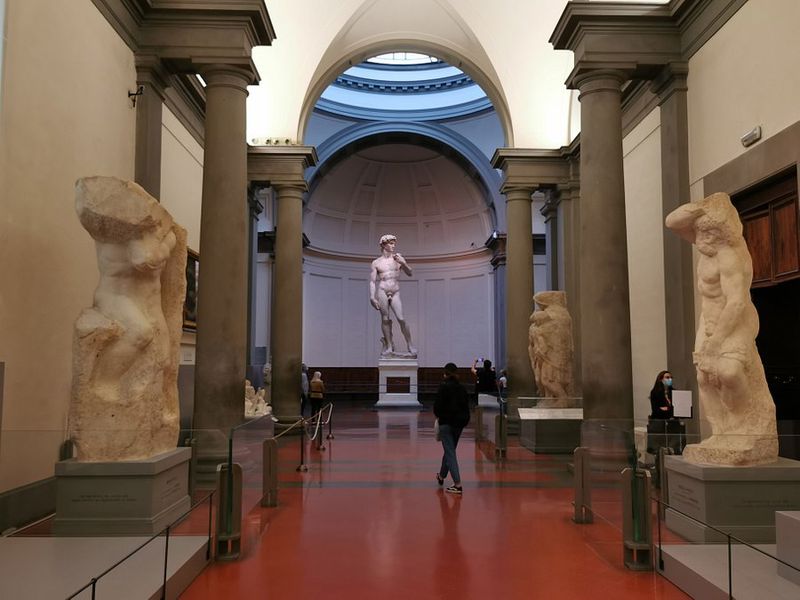
Palazzo Vecchio
The pride of Piazza della Signoria is none other than the Old Palace (Palazzo Vecchio). In the past it was the seat of the Signoria (hence the name of the square), the legislative body during the golden age of the city. It then became the official residence of the Medici, while today it houses the City Hall of Florence. This gigantic palace is one of the most impressive in Tuscany, built in the Roman style, featuring aristocratic gardens, dozens of halls with rare works of art and impressive gates. From here also begins the famous "Vazari Corridor", a secret gallery that leads to the Pitti Palace, in which I will refer below. When you're done with the Old Palace, take some time to explore the square, where you can admire the ornate Neptune's Fountain (Fontana del Nettuno) and an outdoor sculpture gallery, including a replica of the statue of David. Entrance to the palace costs 12.5e.
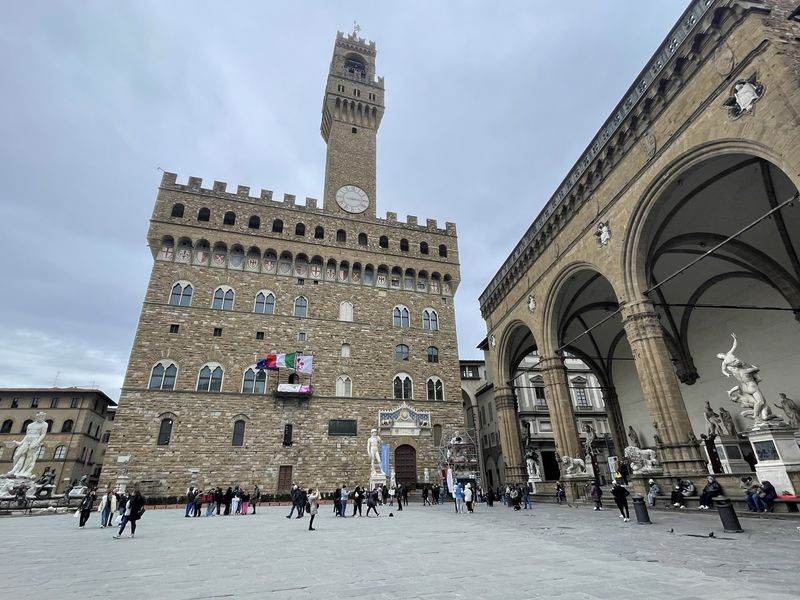
Ponte Vecchio
The much-photographed, well-remembered and well-known Old Bridge (Ponte Vecchio) is Florence's oldest bridge and the only bridge over the Arno River until 1218. The bridge as we see it today was rebuilt after a flood in 1345, while during of World War II was the only bridge in Florence not destroyed by the Germans. It looks like a colorful arch that houses, since the 14th century in its picturesque porch, dozens of jewelry shops and goldsmiths, the paradox is that they are managed by the same families even today! Don't miss the opportunity to cross it and admire the dazzling view from the central "veranda" of the bridge, the green waters of the Arno, the canoes that keep passing by and the new city rising on the other side.
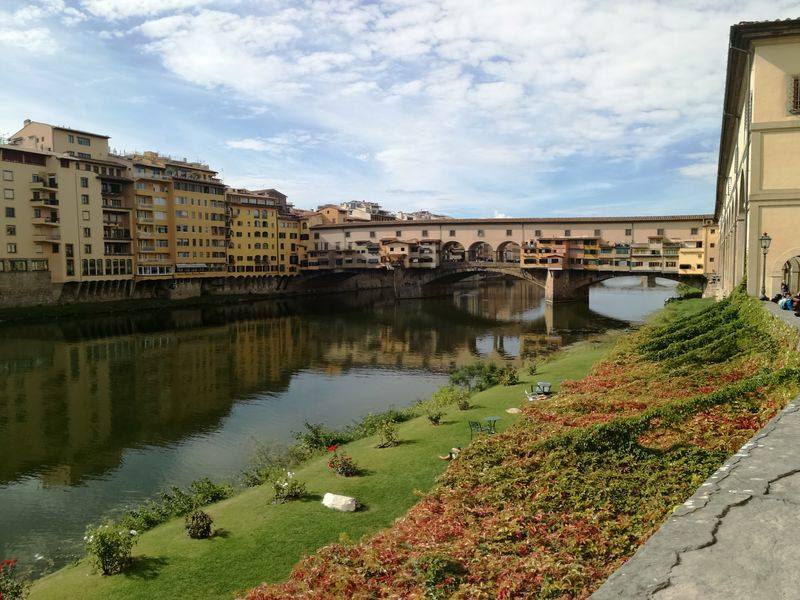
Palazzo Pitti
After entering the secret Vasari gate, you will find yourself in Pitti Palace (Palazzo Pitti). The core of the palace as it stands today dates back to 1458 and was originally the residence of Luca Pitti, an ambitious Florentine banker. The palace was bought by the Medici in 1549 and became the main residence of the families that ruled the Grand Duchy of Tuscany. It developed into a veritable treasury, as successive generations accumulated there paintings, jewels and all kinds of luxurious artefacts. In the late 18th century, the palace was used by Napoleon when he passed through the city, and later briefly served as the royal palace of the newly united Italy until in 1919 King Victor Emmanuel III donated it to the Italian people. Today the palace is the largest museum complex in Florence. The main building has an area of 32,000 square meters and houses many galleries and museums, such as the Palace Gallery (Galleria Palatina), the Gallery of Modern Art (Galleria d'Arte Moderna), the Treasury of the Grand Dukes (Tesoro dei Granduchi), the Fashion and Costume Museum (Museo della Moda e del Costume) and the Porcelain Museum (Museo delle Porcellane). The hallmark of the palace, however, is its beautiful gardens (Giardino di Boboli). The history of the Boboli Gardens begins four centuries ago, when Cosimo I commissioned the designs to Niccolo Pericoli, known as Tribolo, in 1549. Notable parts of the gardens are the Cave of Buontalenti (Grotta del Buontalenti), the Amphitheater with the Roman basin (Anfiteatro) and the Egyptian obelisk (Obelisco egizio) in the center, the Fountain of Neptune (Fontana del Nettuno), the statue of abundance by Giambologna and Tacca, the Casino of the Grand Duke and the Fountain of the Ocean (Fontana dell'Oceano). The entrance costs 16e.
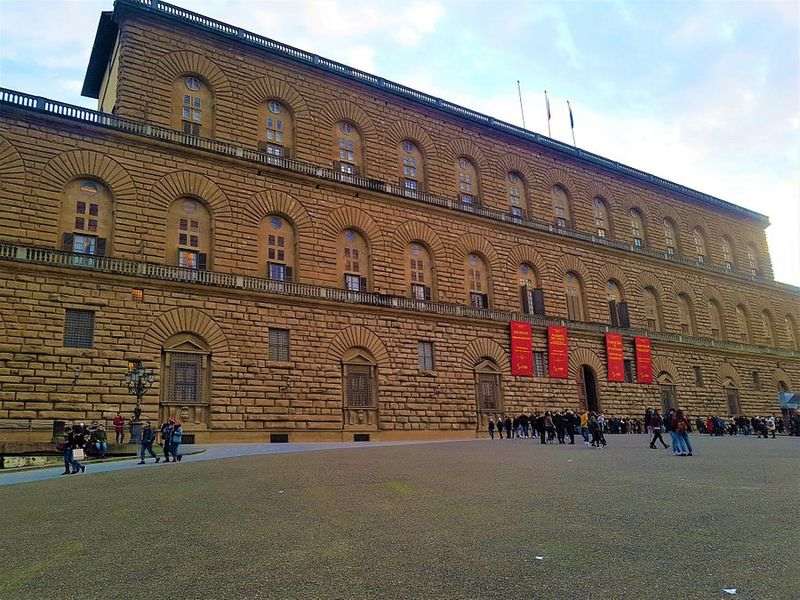
Piazza della Republica
The Liberty Square (Piazza della Republica) is one of the most central squares of the city and the meeting place of the locals for centuries. In its center dominates the Column of Abundance (Colonna dell'Abbondanza). It marks the exact geographical center of the city and forms the border between three of the four historic neighborhoods of Florence (Santa Croce Azzurri, San Giovanni Verdi and Santa Maria Novella Rossi). Part of today's square was once used as a market, and many stories and legends related to Florence originate from this square. According to one of them, in 1245 Saint Peter was trying to preach to a large crowd when the devil, in the guise of an imposing black horse, wanted to disturb the spectators by running wildly into the marketplace and crushing them. Realizing the danger, Saint Peter raised his hand and made the sign of the cross in the direction of the abandoned horse, which suddenly stopped and disappeared. A few centuries later, in memory of this event, Bernardo Vecchietti commissioned Giambologna to create a bronze flagpole in the shape of a little devil, placing it in the corner of his palace between via Vecchietti and via Strozzi. Finally, on the way to this particular square, you will come across the city's famous open-air market, as well as many branded stores to do the necessary shopping (if your wallet can handle it).
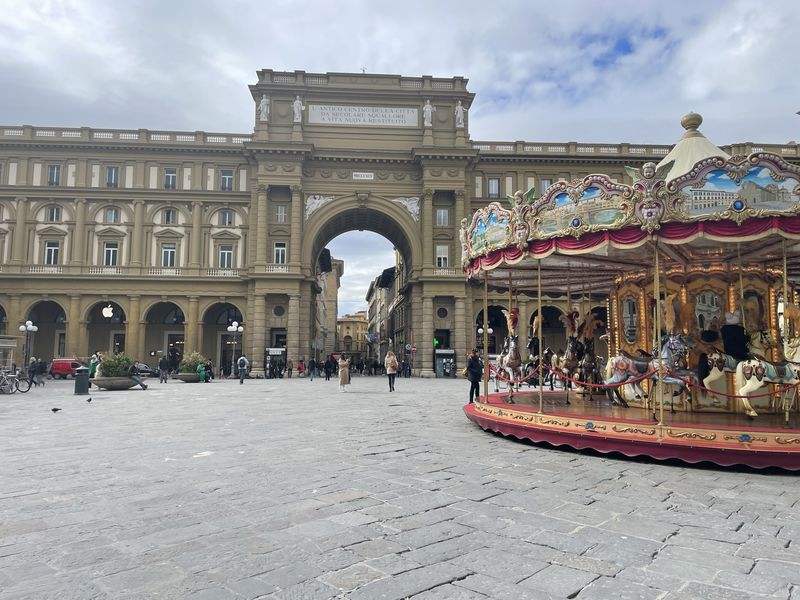
Basilica di San Lorenzo
The Basilica of San Lorenzo (Basilica di San Lorenzo) is one of the largest churches in Florence, located in the center of the city's main square. It is the burial place of all the main members of the Medici family, from Cosimo the Elder to Cosimo III. Also, this particular Basilica is one of the churches that claim to be the oldest in Florence, dating back to 393, when it stood outside the city walls. For three hundred years it was the city's cathedral, before the bishop's official seat was moved to Santa Reparata. Finally, the church is part of a larger monastic complex, containing various important architectural and artistic works. Some of them are the Old Sacristy (Sagrestia Vecchia) by Brunelleschi with interior decoration and sculpture by Donatello, the Laurentian library (Biblioteca Medicea Laurenziana) by Michelangelo, the New Sacristy (Sagrestia Nuova) based on Michelangelo's designs and the Medici Chapels (Cappelle Medicee) by Matteo Nighetti.
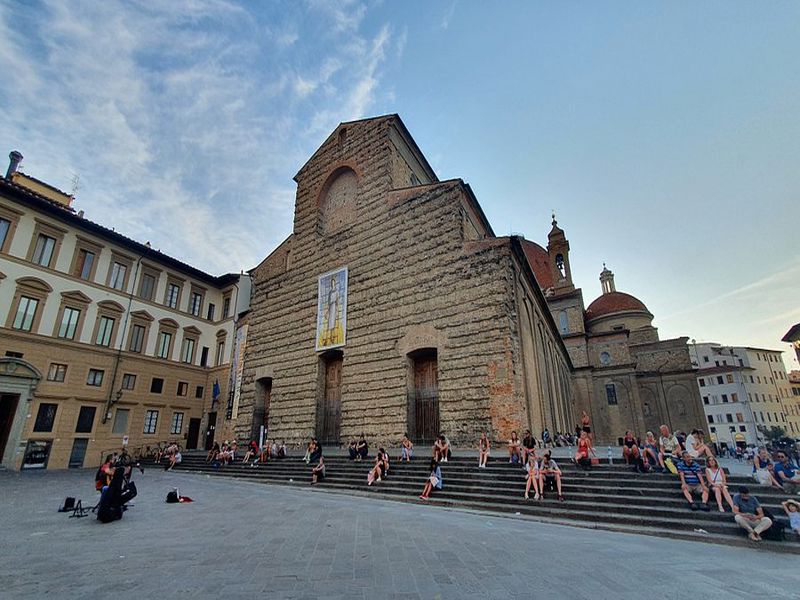
Museo Nazionale del Bargello
The Bargello National Museum (Museo Nazionale del Bargello), is housed in the homonymous palace. It is part of the Bargello Museums together with the Medici Chapels (Cappelle Médicee), the Orsanmichele Church, the Davanzati Palace (Palazzo Davanzati) and the House Martelli (Casa Martelli). It is considered the first museum in Italy (June 22, 1865) and its collection of Renaissance statues is one of the most remarkable in the world! To understand the importance of the museum, consider that what the Galleria Uffizi offers in paintings, this museum offers in sculptures. In fact, in 2016 it was the thirty-seventh most visited museum in Italy, with 213,598 visitors! It includes masterpieces by Michelangelo, Donatello, Ghiberti, Cellini, Giambologna, Ammanati, and other important sculptors, as well as various other exhibits from the Medici collections, such as tapestries, jewelry, weapons, and more. The entrance costs 10e, while there is also a common ticket for all the above museums for 21e.

Santa Maria Novella
Santa Maria Novella isn't at the top of most travel guides, but that definitely needs to change. It is one of the most important Gothic churches in Tuscany, which is in fact an excellent example of the Renaissance style. Its exterior is the work of Fra Jacopo Taledi and Leon Battista Alberti and dates from 1420, while inside you will find masterpieces from the early Renaissance period. The most important of these are Mazzazzo's Holy Trinity, Domenico Ghirlandaio's cycle of frescoes in the Tornabuoni chapel and Giotto's Cross. This particular church is located directly across from the city's central railway station, to which it gave its name! Finally, chronologically, it is the first major basilica in Florence and is the main Dominican church of the city. Admission is free.
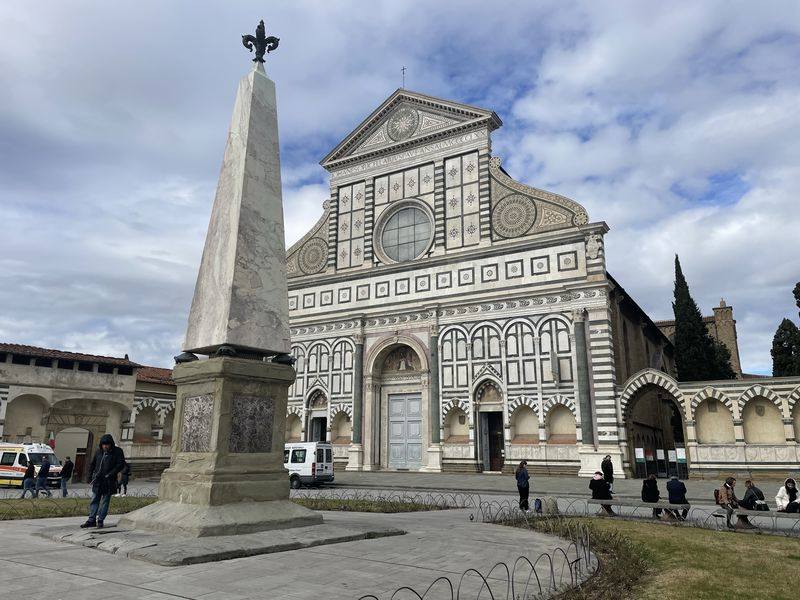
Basilica di Santa Croce
Another charming temple in the city that you should not miss is the Basilica of the Holy Cross (Basilica di Santa Croce). Located in the homonymous square, it is the largest Franciscan church in the world, while its most notable features are its sixteen chapels, many of them decorated with frescoes by Giotto and his students! According to the legend, the basilica was originally founded by Saint Francis himself, but was rebuilt for the Franciscan order in 1294 by Arnolfo di Campio. It is the burial place of many prominent Florentine figures, such as Michelangelo, Rossini, Machiavelli, Foscolo, Gentile and Pisa-born Galileo Galilei. There is also a monument to Dante, but his sarcophagus is empty, since he is actually buried in Ravenna, having been exiled from Florence. The entrance costs 8e.
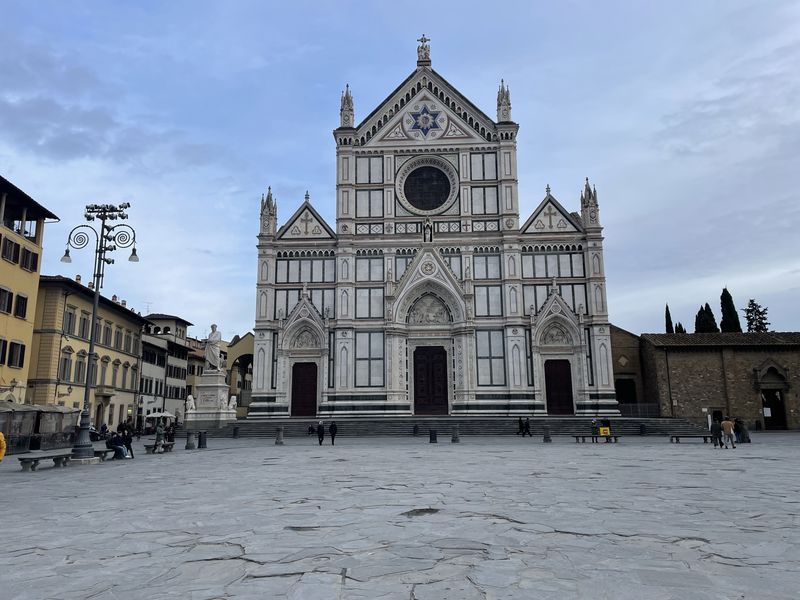
Piazzale Michelangelo
Finally, one of the most charming parts of the city is the Oltrarno, the side beyond the river Arno. Here the tourist "orgasm" relaxes and you will be able to reach the top of the hill and see Florence once again from above by following the signs to Michelangelo Square (Piazzale Michelangelo). The square is apparently dedicated to Michelangelo and there you will find, as I said above, another copy of the statue of David. According to the locals, this particular spot is the best to see the sunset in Florence.
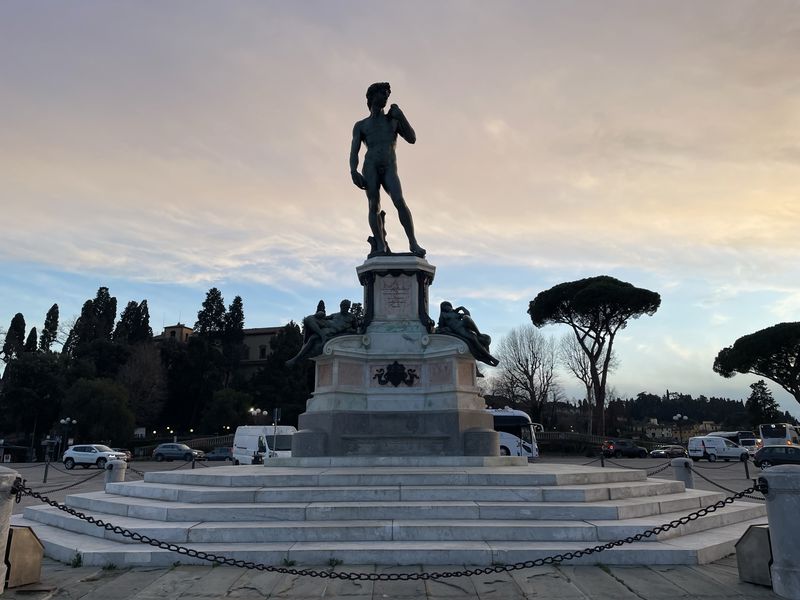
How to go
Unfortunately, there is no direct flight from Thessaloniki to Florence, and you should therefore take a stopover. The cheapest flight you can find is through Rome, with Ryanair at 232€ round trip. However, as I've mentioned in previous articles about Italy, the country's rail network is at a fairly high level, so you might want to try finding a flight to another city like Rome, Bologna or Pisa and from there arrive in Florence by train, something that will surely save you both time and money.
Where to stay
Florence is a relatively small town, where everything is located close to its historic centre. So it’s a good idea finding a hotel or apartment, as centrally as possible. Of course, this also means quite a bit of price, as in the tourist season the cheapest you can find is around 100e per night! A good and relatively affordable solution is the AlGiglio Bottonato, which comfortable and spacious rooms in the historic center.
How to move
I think even the most skeptical, after a first stroll in Florence, will agree that you have to walk this city. Everything is concentrated in the historical center, which is a shame not to walk inch by inch. If you are one of those who enjoy the route better in four wheels, the city has two public bus companies, starting from the railway station and covers the whole city. Another good and relatively economical way to get around is the taxis, which are very easy to stop either on the road or get off one of the dozens of trails.
What to eat
You are in Italy; what else could you eat besides pasta, pizzas and the famous Italian gelato. If you want to escape a little from the usual and try something that exists only in Florence, try the tripe, which you will not find in some expensive restaurant, but in canteens and shops on the street. This is a cow's stomach sandwich that has a strong taste and is definitely not for everyone! An excellent dining option is Gustavino Piazza Signoria, which is a casual restaurant serving mainly Italian flavors and is a favorite of the locals. For delicious Panini, All' Antico Vinaio, while for coffee, Caffe Scudieri, which serves good coffee with a view of the Duomo and Il Ridrullo. Finally, don't miss Rivoire, located in Piazza della Signoria and has the most delicious chocolate in Florence and Venchi.
Useful information

In Italy we travel with a passport or a new type of Police identity card, where the information is written in Latin characters.
In Florence, the language used is, of course Italian, but because of tourism, most know English, and even those who don’t, are willing to help even with gestures.
The currency of the country is the Euro.
Florence is an hour behind Greece (GMT +2).
Take care of your personal belongings as in Florence there is an increased risk of pickpockets and other petty criminals.
The Hellenic Wage Consulate General in Florence is located at Via Cavour 38, 50129 and its phone number is +39 055 2381482.
The transfer to and from Florence Airport is simple, since there is a bus every half hour, which takes you in 30 minutes, to and from Santa Maria Novella train station.
Book museum tickets online to save time and money.
Italy's climate is quite similar to that of Greece, so there are mild winters and hot summers. Ideal time of visit I think it is Fall or Spring.
Recommended excursions→ Pisa, Bologna, San Marino

If this article seemed interesting or contributed to your quality information, then you can like my facebook page: o_thessalonikios or follow me on instagram!
Mouzakidis Pantelis





